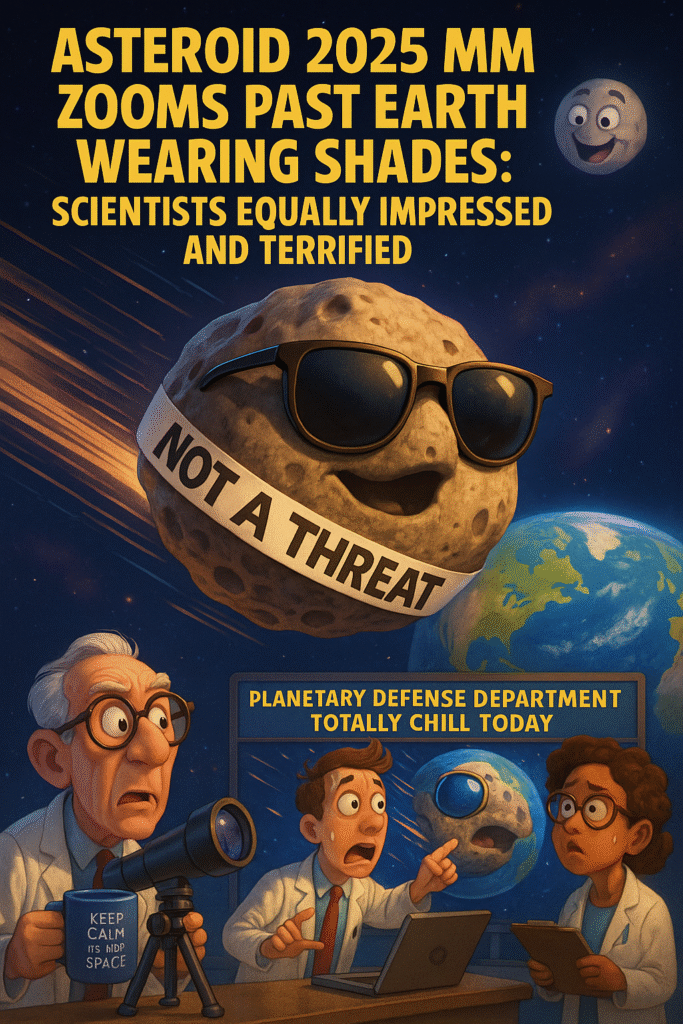The Great Non-Event of 2025: A Cosmic Drive-By
While you were debating pineapple on pizza, a Boeing-sized asteroid named Asteroid 2025 MM casually zipped past Earth on July 1, 2025—just three times the distance of the Moon. Astronomers assured everyone that it was completely safe. Meanwhile, the rest of us spent five minutes googling “How fast is 23,874 mph?” before accepting our fate.
In cosmic terms, this is the equivalent of a boulder doing a burnout outside your front porch while revving “I’m not gonna hit you, bro.” But don’t worry—scientists confirmed that Earth was never in danger. They even said it with a straight face.

It’s the Size of a Plane. What Could Possibly Go Wrong?
Asteroid 2025 MM is around 120 feet (36 meters) in diameter—roughly the wingspan of a Boeing 737. Except this Boeing doesn’t land, doesn’t serve peanuts, and doesn’t have WiFi. It travels at over 38,428 km/hr, which is technically faster than your crush replying to “hey.”
If it had entered Earth’s atmosphere, it would’ve been catastrophic. But hey, it didn’t, so we’re going to laugh about it now and suppress the existential dread till it actually matters.
Asteroid 2025 MM: Scientists Say It’s “Not Hazardous.” Internet Disagrees.
According to NASA’s Planetary Defense Coordination Office (yes, that’s a real thing and not the title of a Marvel sequel), asteroid 2025 MM doesn’t qualify as a Potentially Hazardous Object (PHO).
Why? Because:
- It’s smaller than 150 meters, and
- It won’t come within 7.4 million km of Earth.
2025 MM only came within 1.29 million km. So yes, it’s close—but not worry-your-pants-off close. It’s like that one friend who shows up to your house unannounced but doesn’t come inside. Annoying, but not illegal.
Also Read: NASA+ Lands on Netflix: Now You Can Stream Rocket Launches Like It’s the IPL—But With More Gravity
Aten Asteroids: The Cosmic Freelancers
2025 MM is part of the Aten asteroid family, which means its orbit lies mostly within Earth’s orbit. Think of them as celestial roommates who forgot to pay rent, occasionally crossing your path, then disappearing for years.
These asteroids are known for:
- Living suspiciously close to Earth
- Showing up uninvited
- Being both harmless and terrifying at the same time
Fun fact: The Aten family is kind of the Gemini of asteroid types—charming, unpredictable, and guaranteed to keep things interesting.
Asteroid 2025 MM: Scientists Still Watching, Just In Case It Changes Its Mind
Why are they still tracking it if it’s not a threat?
Because space is dramatic. Things change.
Asteroid paths can shift because of:
- Yarkovsky Effect: Solar radiation giving a gentle nudge, like cosmic peer pressure
- Collisions in the asteroid belt (a.k.a. space bumper cars)
- Internal fractures that turn one rock into a billion flaming surprises
Basically, Asteroid 2025 MM could go rogue in a decade and show up asking Earth for its Wi-Fi password. That’s why telescopes are still pointed at it like it’s a suspicious suitcase at an airport.
Earth’s Official Response: Pretend It’s Normal
Despite the alarming imagery—a space rock the size of a 737 hurtling through space at NASCAR speeds—humanity responded the way it always does:
- Scientists made graphs.
- News anchors said “no need to panic,” thus causing mild panic.
- Twitter renamed it #SkyNugget.
- Your uncle forwarded a WhatsApp message blaming it on 5G.
Meanwhile, Earth just spun silently, hoping this rock wouldn’t boomerang back in 2032 with an attitude problem.
Inside NASA’s ‘Chill But Concerned’ War Room
Inside NASA’s offices, scientists huddled around telescopes and data screens, sipping their seventh coffee, whispering sweet nothings to orbit simulators.
One anonymous astronomer allegedly said:
“We’ve modeled every possible trajectory. Unless it takes a sharp left turn and joins Elon Musk’s Mars mission, we’re good.”
Another just stared out the window, whispering, “We really need a second planet.”
What If It Did Hit Us? Hypothetically Speaking
Okay, let’s indulge the doomsayers for a second.
If asteroid 2025 MM had hit Earth:
- It wouldn’t wipe out humanity
- But it would ruin your day
- Think Tunguska Event (1908) levels of kaboom—flattening forests, disrupting air traffic, and trending on Reddit for weeks
Luckily, it didn’t. But let this be a gentle reminder that our planet is playing cosmic dodgeball on expert mode.
Why Events Like This Matter (Besides Making Great Memes)
Even though Asteroid 2025 MM isn’t a threat, these flybys are important for:
- Improving orbital prediction tech
- Calibrating planetary defense systems
- Making humanity feel both tiny and lucky
And hey, it helps justify funding for future space telescopes. You can’t put a price on “not dying by sky rock,” but Congress definitely tries.
Final Thought: Is This the Universe’s Way of Trolling Us?
Maybe. The universe seems to have a great sense of humor:
- Saturn has a storm shaped like a hexagon
- Uranus spins sideways
- And now we have asteroids wearing sunglasses and sashaying past Earth like it’s a space fashion show
One day, one of these rocks might not miss. Until then, keep looking up—and maybe learn some basic asteroid etiquette.
Disclaimer
This article is a humorous take by Peak View Stories, where satire, sarcasm, and cosmic commentary collide. If you read this thinking the asteroid is actually wearing sunglasses, we envy your imagination. For more reality-adjacent, laughter-first storytelling on space, politics, tech, and everything in between, bookmark Peak View Stories. Because if we’re going down by asteroid, at least let it be with a good headline.